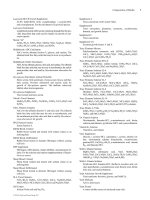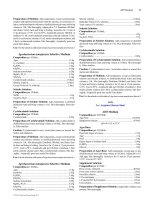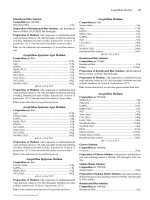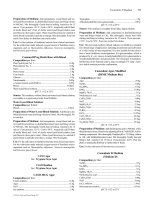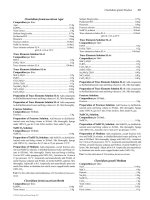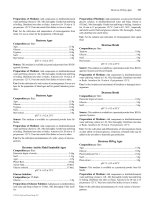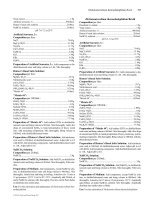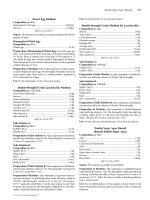Handbook of Polymer Synthesis Second Edition Episode 2 docx
Bạn đang xem bản rút gọn của tài liệu. Xem và tải ngay bản đầy đủ của tài liệu tại đây (1.52 MB, 77 trang )
2
Polystyrenes and Other Aromatic
Poly(vinyl compound)s
Oskar Nuyken
Technische Universita
¨
tMu
¨
nchen, Garching, Germany
I. STYRENE
Discovery of the styrene monomer is credited to Newman [1] who isolated it by steam
distillation from liquid amber, which contains cinnamic acid, yielding styrene via
decarboxylation. The first polymerization was described by Simon [2]. Commercial styrene
polymerization was begun about 1925 [3]. Cracking of ethylbenzene became the major
manufacturing route for the monomer. The first commercialization was based on bulk
polymerization using the can process [4,5]. Polystyrene production has grown by an
average of 2.8% per year over the last 10 years, reaching 8 500 000 metric tons worldwide
in 1995 [6]. The most general-purpose polystyrene is produced by solution polymeriza-
tion in a continuous process with the aid of peroxide initiation. Suspension polymerization
is used for products for which a small spherical form is de sirable. Emulsion polymerization
is the method of choice for ABS resins.
Polystyrene is a glasslike solid below 100
C. Below this temperature it shows
considerable mechani cal strength. Rubber-modified polystyrene is a two-phase system,
rubber dispersed in polystyrene being the continuous phase. Advantage is taken of the
complex interaction of those systems in many applications in which high stress-crack
resistance is needed. Polystyrene is nonpolar, chemically inert, resistant to water, and easy
to process. It is the material of choice for many food-packing, optical, electronic, medical,
and automotive applications. Tensile strength can be increased by controlled orientation
of polystyrene.
A. Synthesis [5,7]
All current styrene production starts with ethylbenzene followed by dehydrogenat ion over
ferrum oxide catalysts yielding crude styrene:
ð1Þ
Copyright 2005 by Marcel Dekker. All Rights Reserved.
Side reactions are reduced by keeping the conversion low or by adding water as a
diluent. It is also possible to synthesize styrene by the oxidation of ethylbenzene:
ð2Þ
ð3Þ
ð4Þ
An alternative pathway starts from toluene and ethene:
ð5Þ
ð6Þ
It is also possible to synthesize styrene from butadiene:
ð7Þ
Physical properties and health and safety information for styrene are given in the
literature [8].
B. Homopolymerizat ion
The C–C double bond of styrene can act either as electron-donating or as electron-
withdrawing center. Therefore, it cannot only be polymerized by radicals but also
anionically or cationically or by coordination initiato rs.
Copyright 2005 by Marcel Dekker. All Rights Reserved.
1. Radical Polymerization
Styrene can be polymerized without a chemical initiator simply by heating (spontanous
polymerization). The first step is a Diels–Alder reaction.
ð8Þ
Only the axial isomer can react with a further styrene atom, yielding two radicals,
which can start a radical polymerization:
ð9Þ
Some of the possible dimers, including 1-phenyltetraline, and a trimer have been
identified [9–11]:
ð10Þ
This type of polymerization requires third-order initiation kinetics [12,13]:
R
i
¼ k
d
M½
3
Consequently, the rate of propagation should be of 5/2 order with respect to styrene
[13,14]:
R
p
¼ k
p
k
d
2k
t
1=2
M½
5=2
However, the reaction does not follow a simple kinetic order with respect to mono-
mer over the entire range of conversion and temperature. The order is negative below
50
C. At 75
C the polymerization is zero order in monomer for the first 65% conversion.
At 127
C the polymerization is first order for the first 85%. Only above 200
C does the
polymerization follow theory [15].
a. Initiators. The list of initiators available for radical polymerizati on of styrene
is very long [16–18], including azo compounds, peroxides, redox systems and many more.
An interesting development is the application of initiators like
ð11Þ
which decompose to form four radicals. It is even more interesting to have a different half-
life for both peroxide groups. This presents novel opportunities for changing the molecular
weight and its distribution [19,20].
Copyright 2005 by Marcel Dekker. All Rights Reserved.
b. Inhibitors. During shipping and storage styrene needs an inhibitor. The most
efficient inhibitors—quinones, hindered phenols, and amines [21]—require traces of
oxygen to function. t-Butyl-catechol at 15 to 50 ppm is the most common inhibitor
for commercial styrene [22]. It is also possible to use nitrophenol, hydroxylamine, and
nitrogen oxide compounds [23]. The inhibitors have to be removed before polymerization,
in order to avoid an induction period.
Traces of metal such as iron or copper [24] and sulfur compounds [25] are the cause
of retardation effects in styrene polymerization.
c. Chain Transfer. In styrene polymerization the chain transfer agent can be
the solvent, monomer, initiator, polymer, or an added chemical agent. As C
tr
¼ k
p
/k
tr
increases, the chain transfer agent becomes more effective. Some examples are given in
Table 1. The most important property affected by chain transfer is the molecular weight
of the polymer. The transfer to monomer has a value of 10
À5
which can be neglected.
However, since the transfer constant to the Diels–Alder dimer axial-1-phenyltetralin is
about 113 at 80
C [26], this may cause experimental error. Any transfer to polymer would
lead to branched structures in the final product. Although this reaction has been inves-
tigated to some extent, there is no conclusive evidence that it is an important reaction [27].
The most important aspect of chain transfer is the control of molecular weight by the
adequate use of added transfer agent. Mercaptanes are by far the most widely used
chemicals for this purpose.
d. Termination Reactions. The free-radical polymerization of styrene is termi-
nated almost exclusively by the combination of two growing chains [29,30]:
ð12Þ
Termination is diffusion controlled at all temperatures below 150
C [31,32]. Increasing
viscosity leads to a reduction in the termination rate [33]. However, the resulting
Trommsdorff effect is comparably small for polystyrene [22].
Table 1 Chain transfer constants in styrene polymerization [28].
Compound C
tr
T/
C
Benzene 2 Â 10
À5
100
Toluene 5 Â 10
À5
100
Ethylbenzene 1.4 Â 10
À4
100
Isopropylbenzene 2 Â 10
À4
100
Styrene 5 Â 10
À5
100
Dichloromethane 1.5 Â 10
À5
60
Chloroform 5 Â 10
À6
60
Tetrachloromethane 1.8 Â 10
À2
100
1-Dodecanthiol 1.3 Â 10
1
130
1-Hexanthiol 1.5 Â 10
1
100
Ethylthioglyconate 5.8 Â 10
1
60
Copyright 2005 by Marcel Dekker. All Rights Reserved.
e. Processing [34]. Free-radical polystyrene can be synthesized either by bulk,
solution, suspension, or emulsion techniques. Techniques for preparing polystyrene on a
laboratory scale are described in detail in Refs. [35–37]. The bulk process needs pure
styrene; it is very simple and yields polymers with high clarity. Due to its poor control,
this process is not used commercially. In solution polymerization styrene is diluted
with solvents, which makes temperature control easier. However, solvents normally
reduce the molecular weight and polymerization rate. Both processes can be carried out
either in batch or continuously. The advantages are more uniform products and low
volatile levels. The main disadvantage is the transportation of highly viscous finished
product.
Suspension polymerizati on is still an important mode of polystyrene production,
although it has lost ground to continuous solution polymerization. The polymerization
system contains monomer suspended in water, stabilizing agents, and initiators to speed
polymerization. The easy heat control and removal of the finished polymer count as
advantages. Contamination with stabili zing agents is considered a disadvantage.
Emulsion polymerization requires water as a carrier with emulsifying agents. It yields
extremely small particles. Advantages are rapid reactions and excellent heat control.
Disadvantages are the contamination of polymer with the emulsifier, water, its deficit
in clarity, and the limitation to batch processing. However, this type of processing is
important for ABS polymers.
2. Controlled Radical Polymerization
The controlled radical polymerization combines the advantages of living ionic systems,
as there are narrow molecular weight distributions, linear increase of the DP with
the reaction time and the possibility of the formation of block copolymers, with the main
advantage of the radical polymerization, the low sensitivity against impurities. The general
idea of controlled radical polymerization is to avoid the bimolecular, irreversible
termination reactions, typically obtained in a free radical polymerization (combination,
disproportionation etc.) by decreasing the number of growing radical chains. Thus,
although the reaction itself beco mes comparably slow, the molecular mass can be very well
controlled and very narrow molecular weight distributions can be obtained.
Early attempts to realize the controlled radical polymerization of styrene involved
the concept of reversible termination of growing polymer chains by iniferters (initiation,
transfer, termination) [38]. These iniferters based on dithiocarbamates were the first
species with photochemically labile C–S bonds.
ð13Þ
Another way of reversible termination was introduced by the same group [39,40].
They showed, that at the decomposition of phenylazotriphenylmethane both a phenyl
Copyright 2005 by Marcel Dekker. All Rights Reserved.
and a trityl radical are generated. The phenyl radical initiates polymerization, while the
trityl radical does not, due to its mesomeric stabilization.
ð14Þ
Instead, the trityl radical acts as a radical trap and efficiently terminates polymeri-
zation by primary radical coupling. As a result of steric crowding between the pendant
groups on the polymer chain and the phenyl groups of the trityl moiety, as much as
a result of the stability of the triphenylmethylradical, the C–C bond can redissociate at
elevated temperature and add more monomer.
ð15Þ
Following this approach, Rizzardo et al. and Georges et al. introduced the use
of stable nitroxide free radicals, such as 2,2,6,6-tetramethylpiperidinyloxy (TEMPO), as
reversible terminating agents to cap the growing polymer chain [41,42].
ð16Þ
It has been demonstrated, that at elevated temperatures narrow molecular weight
distribution polystyrene (PDI ¼ 1.1–1.3) could be prepared using bulk polymerization
Copyright 2005 by Marcel Dekker. All Rights Reserved.
conditions. In the polymerization of styrene, temperatures around 120
C are required in
order to obtain a sufficient rate of monomer insertion, because of the stability of the C–O
bond.
A very similar approach is the use of triazolinyl counter radicals as an alternative
to the nitroxides [43,44]. The electron spin density is not localized, as in the case of
TEMPO, but delocalized in a extended p system.
ð17Þ
With a polymerization temperature of 120
C, a three-fold higher polymerization
rate in comparison to TEMPO could be obtained in styrene polyme rization. Furthermore,
in contrast to TEMPO mediated polymerization, polymers up to a molecular weight
of 100 000 g/mol can be obtained in good yields. The mechanism of the polymerization
process is not identical to the TEMPO mediated polymerization, but the control is
introduced by a self regulation process [45]. In 1995, a further approach to controlled
radical polymerization, the Atom Transfer Radical Polymerization (ATRP) was indepen-
dently reported by Matyjaszewski [46] and Sawamoto [47]. These systems are based on the
dynamic equilibrium of a reversible redox reaction between halogen endgroups of the
polymers and transition metal catalysts. The catalysts are mainly Cu(I), Fe(II) or Ru(II)
complexes with different ligands. The copper based systems usually contain nitrogen
ligands like bipyridines, multidentate amines and Schiff bases. A general review over
copper mediated ATRP is given in Ref. [48]. The ruthenium based catalysts show a wide
variety of structures with arenes, phosphines and halogens as ligands [49]. Iron based
catalysts are also applied, most of them are containing bipyridines, trialkylamines,
phosphines or phosphites [50].
ð18Þ
The ATRP allows the synthesis of very narrow dispersed polystyrenes (PDI 1.1).
Recently, a new mechanism for controlled radical polymerization of styrene,
the RAFT (reversible addition fragmentation and transfer) process, has been presented
[51,53]. This type of bimolecular exchange process employs reversible addition of
Copyright 2005 by Marcel Dekker. All Rights Reserved.
the radicals to a nonpolymerizable double bond. The RAFT process is best represented
by the use of several dithioesters as transfer reagents and the mechanism can be divided
in three main steps. The addition of a growing polymer chain to the transfer reagent with
subsequently homolytic fragmentation of the S–R bond (transfe r) is the first step:
ð19Þ
The reinitiation of a new active polymer chain with the resulting radical R
.
follows.
ð20Þ
Subsequent addition-fragmentation s teps set up an e quilibrium between the two pro-
pagating radicals and the dormant polymeric dithiocarbonylthio compound by way of an
intermediate stabilized radical. Th roughout the polymerization (and a t the end) the v ast
majority of the po lymer chains are e nd capped by a thiocarbonylthio group (dormant chains).
ð21Þ
In general, every kind of monomer needs a different dithioester for best results,
whereby the most suitable compound for styrene contains phenyl for Z and 2-phenyl-
propyl for R. Polystyrene with a PDI down to 1.07 can be obtained by use of this
compound [52].
3. Anionic Polymerization
The phenyl group of styrene is able to act as an electron-donating or an electron-
withdrawing center. This situation allows the growing end of the polymer to be either a
carbeniumion or a carbanion, as shown in more detail in this chapter.
Copyright 2005 by Marcel Dekker. All Rights Reserved.
a. Initiation. A highly purified monomer is reacted with a strong base. Although
several initiators are known, organolithium compounds are the most studied and probably
the best understood initiators [54,55].
ð22Þ
This initiation is much faster than the propagation step. All styryl anions are
therefore formed almost instantaneously. Since no termination occurs, the degree of
polymerization can be calculated easily on the basis of the following equation:
DP
n
¼
½M
½I
Furthermore, one can observe that
DP
n
% DP
w
% DP
z
This has been discussed in detail in several reviews [56–58].
b. Propagation. The ideal polymerization of this type (the cationic polymerization
follows the same kinetics) obeys the following equation:
R
p
¼ k
p
Á½C
Æ
Á½M
where C
Æ
represents the molar concentration of active ionic chain ends. The rate constant
is strongly affected by the solvent [59]: for example k
p
is 2 L mol
Àl
s
À1
in benzene compared
to 3800 L mol
Àl
s
À1
in 1,2-dimethoxyethane at 25
C. In addition to solvent, the counterion
affects the rate of polymerization. The effect of the counterions is often explained on
the basis of their sizes (e.g., increasing solvation with decreasing size yields a greater
concentration of free ions and higher polyme rization rates) [60]. For the growing end
of poly(styryllithium), an association of two growing chains has been discussed [61,62].
This complex dissociates if polar solvents such as THF and diethylether are added,
resulting in an increase in the polymerization rate. Instead of using a monofunctional
initiator, it is possible to use a bifunctional anionic initiator.
One of the best described systems involves the reaction between sodium and
naphthalene, forming a radical anion that transfers this character to the monomer.
The two radical anions combine quickly to form a dianion [57].
ð23Þ
Copyright 2005 by Marcel Dekker. All Rights Reserved.
ð24Þ
ð25Þ
ð26Þ
Another bifunctional initiator is formed by the reaction of 1,3-bis(1-phenylvinyl)-
benzene with organolithium, yielding a dianion with good solubility in hydrocarbons
[63–65]:
ð27Þ
Copyright 2005 by Marcel Dekker. All Rights Reserved.
A similar system was described by Guyot et al. [66]:
ð28Þ
The living nature of polystyryl anion has been applied for the system of diblock,
triblock, and multiblock copolymers [67–70]. Examples for commercial products are
Kraton rubber (Shell Oil Co.), a styrene–butadiene–styrene triblockcopolymer, and
Styrolux (BASF AG), a styrene–butadiene–styrene starblockcopolymer. First, a block
polystyrene can be prepared that remains active; then a new monomer can be added.
Termination with dimethylsilicium dichloride yields a triblock copolymer:
ð29Þ
Another advantage of the living nature of the chain end is that it can be converted
into interesting functional end groups [71–74]. The reactions of the anionic end group
can be divided into three categories: (1) coupling for chain extensions, yielding special
structures such as star-branched polymers; (2) coupling with other polymers, yielding
block or graft copolymers; and (3) coupling with polymerizable groups for the reaction
in further polymerizations as monomer (macromonomer). Reaction of poly(styrylli thium)
first with oxirane, then with methacryloyl chloride, is an example for the transformation
of the living chain end into a polymeric monomer [75,76].
ð30Þ
Copyright 2005 by Marcel Dekker. All Rights Reserved.
Copolymerization of this macromonomer with common monomers such as methyl
methacrylate yields graft copolymers that are not contaminated with homopolymers.
Many examples of this reaction type are described in the literature [77–81]. More details
are given later in the chapter.
4. Cationic Polymerization
The commercial use of cationic polymerization of styrene is practically nonexistent at this
time because of the low temperature needed, the uncontrollable molecular weight, and
residual acidic initiator. However, since numerous basic papers are published on this topic
it is discussed here briefly. The initiators of a cationic polymerization of styrene can be
carried out in the presence of strong acids like: protonic acids like perchloric, hydrochloric
or sulfuric acid or Lewis acids such as BF
3
, BCl
3
, and AlCl
3
[82–86]. Additionally,
alumina, silica, and molecular sieves were used to initiate cationic polymerization. A list
of studies of the cationic polymerization of styrene is given in Ref. [86]. One of the
most interesting developments in this field is the polymerization of styrene initiated by
HClO
4
[87]. The reaction involves three stages: stage 1: fast polymerization, showing
electrical conductivity and all orange–red color; stage 2: characterized by the absence of
conductivity and color; and stage 3: when the conductivity and color reappear. These
observations are explained by intermediate perchlorate esters [88].
Cationic polymerization of styrene in the presence of salts such as (n-Bu)
4
N
þ
ClO
4
À
has been shown to accelerate the polymerization rate compared to the rate for salt-free
polymerization [89]. This result is explained on the basis of the following reaction:
ð31Þ
Polymerization of styrene with BF
3
Á OEt
2
in the presence of electron acceptors (EA)
such as tetracyanoethylene (TCE) and chloranil (CA) strongly increased its rate if
chlorinated solvents were used. This was not observed in the ‘donor solvent’ benzene
and also not in the acceptor solvent nitrobenzene [90]. This is explained by complexation
of the counterion, enhancing the ion separation and therefore increasing the rate.
ð32Þ
Interesting effects were observed if cationic polymerization was carried out under
an electric field [91,92]. Depending on the solvent, the degree of ion separation is decreased
under the influence of the electrical fie ld. However, if toluene is applied, the effect is small
due to the low " value of the solvent. In the range of intermediate values of
" (dichloroethane) the highest changes in rate are observed. In nitrobenzene, a solvent
with high " values, the ion separation is almost complete. Therefore, application of an
Copyright 2005 by Marcel Dekker. All Rights Reserved.
external field does not affect the free ion concentration and the rate. Some research was
carried out in the field of electro-initiated polymerization of styrene [93].
When the system Et
4
N
þ
BF
4
À
/styrene/nitrobenzene was electrolyzed with 0.35 mA
for 60 min, some polystyrene was observed around the anode. Another field in which
cations are assumed to be the intermediate is styrene polymerization by g-rays [94].
Careful work showed that the rate of polymerization gradually changes from 0.5 order,
indicating a radical process, to a first-order process, sugge sting an unimolecular
termination characteristic for the cationic mechanism [95–99].
Normally, molecular weight is difficult to control in ca tionic polymerization of
styrene. This is not only because of transfer to polymer and solvent but also of transfer to
monomer. Friedel –Crafts reactions during growth with aromatic solvents significantly
decrease the molecular weight [100]. A living carbocationic polymerization of styr ene has
been described [101]:
ð33Þ
Addition of further monomer results in an increase in molecular weight. The danger
of termination by indane formation seems to be reduced by adding the monomer in small
portions [102,103]:
ð34Þ
5. Coordination Polymerization
Styrene can be polyme rized to stereoregular structures by coordination catalysts. Highly
isotactic polystyrene is prepared using Ziegler–Natta-type catalysts obtained from the
reaction between TiCl
4
and AlEt
3
[104,105] and of a TiCl
3
/Al(i-Bu)
3
mixture [106] in
a temperature range of 0
Cto10
C. The Al/Ti ratio has to be 3:1 for the formation
of isotactic polystyrene [107,108]. A detailed description of preparations for isotactic
polystyrene is given in Ref. [109].
Copyright 2005 by Marcel Dekker. All Rights Reserved.
Syndiotactic polystyrene has also been described [110–113]. A mixture of
methylaluminoxane (MAO) and cyclopentadienyltitanium (III)chloride was used as
catalyst, whereby the active species was postulated to be a cationic complex [CpTi(III)
(Polymer)Sty]
þ
[114]. The stereocontrol in this catalyst is induced by the phenylgroups of
the growing polymer chain and not by the symmetry of the catalyst as in most type of
coordination catalysts.
ð35Þ
Syndiotactic polystyrene (sPS) is a hard, stiff material with high temperature stability
and excellent isolator properties. The E-module of ca. 10
9
Mpa is similar to that of poly-
amide 66, and therefore much higher than in amorphous polystyrene. These properties
lead to new, very interesting applications, especially if sPS is blended with polyamides [6].
C. Copolymerization
A large number of copolymers can be prepared with styrene. However, only the most
interesting combinations of monomers are described here. From the reactivity ratios r
1
and r
2
, one can calculate the composition of the instantaneously produced copolymer with
the following equation:
½M
1
½M
2
¼
1 À r
2
1 À r
1
The reactivity ratios for selected comonomers are listed in Table 2.
1. Poly(styrene-co-methyl methacrylate) (PSMMA)
Due to the reactivity ratios, the copolymer shows less composition shift than other systems
do [121]. The copolymer should contain more than 30 wt % styrene to avoid degradation
at temperatures above 250
C [122]. The SMMA copolymers are interesting because
of improved light, outdoor and weather stability, and higher clarity [123]. These copoly-
mers are produced by either bulk, solution , or suspension polymerizat ion. Alternating
structures are derived in the presence of ZnCl
2
[124] or EtAlC1
2
[125].
2. Poly(styrene-co-maleic anhydride) (PSMA)
Copolymerization of styrene with maleic anhydride yields alternating structures, probably
due to the formation of charge transfer complexes [126,127]. Statistical copolymers
Copyright 2005 by Marcel Dekker. All Rights Reserved.
are produced if the process is carried out in a continuous ba tch reactor [128] . Copolymers
with small amounts of maleic anhydride are the basis for several commercial products,
whereby the primary benefit of maleic anhydride is a greatly increased heat resistance.
3. Poly(styrene-co-acry lonitrile) (PSAN)
PSAN is probably the most important copolymer of styrene because of its improved
chemical resistance, improved mechanical properties, and better heat stability.
The disadvantage is that a higher portion of acrylonitrile often yields yell ow products
[129,130].
For high-quality PSAN, formation of homopolystyrene has to be avoided. A small
amount of polystyrene will produce hazy PSAN because of phase separation. The
copolymerization is initiated by radicals and is carried out in bulk, solution, suspension,
and emulsion [131–133]. Alternating copolymers result if ZnCl
2
or EtAlC1
2
was added to
the monomer mixture [134].
4. Poly(styrol-co-acrylic ester) and Poly(styrol-co-acrylic acid salts)
This copolymerization is initiated by radicals in bulk, solution, or suspension. Emulsion
polymerized copolymers of styrene and acrylic esters are important basic materials
for coating resins. Copolymerization of styrene with acrylic acid salts (Zn
2þ
,Co
2þ
,Ni
2þ
,
and Cu
2þ
) in methanol as solvent yields copolymers that form ionomers with properties of
reversible networks [135].
5. Poly(styrene-co-butadiene) (SB) and
Poly(styrene-co-acrylonitrile-co-butadiene) (ABS)
SB polymers are prepared by emulsion polymerization [136]. Molecular weight is
controlled by the addition of a chain transfer agent. ABS rubber is produced in emulsion
[137,138] or solution [139, 140]. The polybutadiene is generally prepared separately, then
the SAN copolymerization is started in presence of a certain amount of polybutadiene.
Under certain conditions the rubber is grafted by the growing chain. Both products show
very high stress resistance in contrast to pure PS.
6. Copolymerization with Divinylbenzene
Copolymerization of styrene with small amounts of bifunctional monomers such as
divinylbenzene is used for the synthesis of networks. The polymerization technique of
choice is bead polymerization. Polymer porosity can be controlled by the addition of
polystyrene, which can be extracted after polymerization has been completed. Sulfonation
of such netw orks yields cation-exchange resins; anion-exchange resins can be synthesized
Table 2 Styrene (M
1
) comonomer reactivity ratio; a comprehensive list of reactivity ratios is given
in Ref. [120].
Monomer 2 (M
2
) r
1
( ¼ k
11
/k
12
) r
2
( ¼ k
22
/k
21
) T/
C Ref.
Methyl methacrylate 0.52 0.46 60 [115]
Maleic anhydride 0.02 0.00 80 [116]
Acrylonitrile 0.4 0.04 60 [117]
Butadiene 0.5 1.40 50 [118]
1,3-Divinylbenzene 0.65 0.60 60 [119]
Copyright 2005 by Marcel Dekker. All Rights Reserved.
by chloromethylation followed by nucleophilic substitution of the chlorine by amine
groups and quaternization of the amino groups [141].
D. Block Copolymers
Block copolymers containing two different monomers are industrially synthesized by
means of anionic techniques exclusively. Three pathways are possible:
1. Adding a monofunctional initiator to a mixture of monomers, if the reactivity
ratios are different enough; otherwise, it is more convenient to polymerize one
monomer to complete conversion and then add the other monomer. Following
the first line, A–B-diblocks can be produced. The stepwise addition of different
monomers leads to tri- and multiblocks.
2. Bifunctional initiators are used for the synthesis of triblock copolymers
3. Triblock and star-shaped polymers are available if the polymerization of
one monomer is started with a monofunctional initiator, then the second
monomer is added. Finally, the polymerization is terminated by adding a two- or
multifunctional terminator.
Normally, blockcopolymers from styrene and butadiene are synthesized by methods 1 and
3. These reactions are reviewed in Ref. [142]. From a mixture of styrene and 1,3-butadi ene
in a nonpolar solvent, first the 1,3-butadiene is polymerized. With increasing relative
concentration, more and more styrene will be incorporated into the polymer chain until
only styrene is left forming the styrene block [143]. The sequence is affected by the addition
of polar substances favoring the incorporation of styrene from the beginning [144].
A complete description for the synthesis of triblock poly(styrene-isoprene-styrene) is given
in Ref. [145].
Pathway 2 is generally chosen in the academic literature. In addition to sodium
naphthalene, dilithium compounds are often used [146–150]. The following terminators
are described for the third pathway: silicon tetrachloride and tintetrachloride dicarbonic
acid ester [151], divinylbenzene [152], and polymers formed from divinylbenzene [153]
containing numerous vinyl groups yielding star-shaped polymers. Block copolymers of
styrene and butadiene or isoprene are synthesized commercial ly in large ranges.
For the synthesis of block copolymers containing styrene and methyl methacrylate,
a living polystyrene is formed in the first step, then MMA is ad ded at low temperature
(À78
C) to avoid reactions of the living polyanion with the ester group [154–156]. Other
combinations of monomer s are possible if a living polymerization is terminated with
a dichloroazo initiator, yielding a polymeric initiator useful for further polymerizations
[157,158]:
ð36Þ
Copyright 2005 by Marcel Dekker. All Rights Reserved.
A possibility to synthesize block copolymers by conventional radical polymerization
is given by the application of polymeric initiators [162]. Partial decomposition of the
polymeric initiators in the presence of styrene yields block copolymers containing
polystyrene and part of the polymeric initiator, still containing some initiator fun ctions.
These functions can be decomposed in a following step in the presence of an additional
monomer yielding block copolymers [157,159–161].
Block copolymers can also be synthesized by controlled radical polymerization [162].
This technique is very interesting for probable industrial applications, because of its low
sensitivity against impurities and the mild reaction conditions. In principle, all methods
of the controlled radical polymerization, as they are described in the chapter above, can be
utilized more or less successfully for the formation of block copolymers.
Georges et al. showed the the formation of block copolymers of styrene with
butadiene, isoprene, acrylate and methycrylate by use of TEMPO or Proxyl(2,2,5,5-
tetramethyl-1-pyrrolidinyloxy) as stable counter radicals [163,164].
ð37Þ
If nitroxyl radicals are used in the presence of organoaluminium complexes in
association with various ligands, the homolytic cleavage of the counter radical is strongly
activated [165–167]. If such systems are applied to vinyl acetate (VAc) or MMA,
the produced polymers undergo further stepwise polymerization of styrene, leadin g to
PVAc-b-PSt or PMMA-b-PSt.
ATRP is also a method to obtain blockcopolymers from different monomers with
styrene [168,169]. If the first block is terminated with a halogen end group, it works as
a macroinitiator in the presence of transition metal catalysts under a reversible redox
mechanism, following the same scheme as in homopolymerization. The formation of
tri- and multiblockstructures is also practicable.
The RAFT process also allows the formation of block copolymers from styrene
[170]. After polymers have been synthesized in the presence of dithioesters as transfer
reagents, they are terminated with a dithioester group. This group can be easily activated
with small amounts of a conventional radical initiator, so that the polymerization
of the second block proceeds. With this method, block copolymers of styrene with
N,N-dimethylacrylamide, methylstyrene or methyl methacrylate have been synthesized.
Copyright 2005 by Marcel Dekker. All Rights Reserved.
E. Graft Copolymerization
1. Polystyrene Backbone
Graft copolymers containing styrene in the main chain and other monomers in their
side chains are available by numerous methods, including conventional radical [171],
controlled radical, anionic [174], and cationic [175] polyme rization and by copoly-
merization of macromonomers [80,174]. Grafting methods via conventional radical pol y-
merization are reviewed by Nuyken and Weidner [171]. The following reaction scheme
demonstrates the principles and universality of the methods applying polymeric initiators:
ð38Þ
Grafting via controlled radical polymerization follows the same principle.
Copolymerization of styrene with styrene derivatives, containing a nitroxyl group [172]
or a halogen group [173] results in a macroinitiator for graft copolymerization via the
grafting from method.
ð39Þ
Copyright 2005 by Marcel Dekker. All Rights Reserved.
Another way is to brominate poly(s tyrene) with NBS to obtain a macroinitiator for
graft copolymerization via ATRP [176].
Furthermore, copolymers of styrene and suitable monomers can be grafted via
anionic mechanism [177,178]:
ð40Þ
ð41Þ
Examples of cationic grafting are given by Kennedy et al. [175]:
ð42Þ
In another example, a copolymer of styrene and acryloyl chloride is reacted with
silver hexafluoroantimonate and then grafted with THF [179,180]:
ð43Þ
The macromonomer method is probably the most promising development at present
concerning the synthesis of well-defined graft copolymers. The developments in this field
up to 1999 have been reviewed by Ito and Kawaguchi [181]. Any macromonomer having
a head group that is copolymerizable with styrene can be utilized for this purpose.
Copyright 2005 by Marcel Dekker. All Rights Reserved.
2. Polystyrene Sidearm
The most important example of graft copolymers having polystyrene sidearms is high-
impact polystyrene (HIPS), in which polystyrene is the continuous phase and poly-
butadiene grafted with polystyrene forms the separated phase. Grafting occurs when some
of the radicals react with the double bonds in polybutadiene [182–186]. Grafting is
also possible onto poly(ethene-co-propene-co-butadiene) [187] and polyacrylic ester [188].
High-impact polystyrene is reviewed in detail in Ref. [189].
Graft copolymers can also be synthesized by a macromonomer method [80,174,
181,190]. The advantages of this method are its variability and the fact that homo-
polymerization can be avoided. The following example can be considered as representative
for other possibilities: Radical polymerization of styrene in the presence of iodine-acetic
acid yields polystyrene having carboxyl ic end groups. Reactions of this functionalized
polymer with glycidyl-methacrylate yield a macro-monomer having a methacrylic end
group [191].
ð44Þ
ð45Þ
ð46Þ
ð47Þ
ð48Þ
Another method to develop polystyrene terminated by a methacrylic unit is descri bed
by Schulz and Milkovich [78]. There, a living polystyrene is converted into an alcoh olate
function by addition of oxirane and then esterificated with methacrylic chloride.
Copyright 2005 by Marcel Dekker. All Rights Reserved.
3. Branched and Hyperbranched Polystyrene
Frechet et al. first presented a way to obtain branched and hyperbranched polystyrene
via cationic polymerization [192], which is c alled the self condensing vinyl polymerization.
In this method, 3-(1-chloroethyl)ethenyl benzene was the monomer and has been poly-
merized in the presence of SnCl
4
.
Matyjaszewski et al. presented a route to branched and hyperbranched polystyrene
via ATRP in presence of Cu(I) [193]. In this case the monomer was p-(chloromethyl)-
styrene (CMS). CMS acts as both initiator and monomer. The degree of branching can be
varied by adding different amounts of styrene.
ð49Þ
The TEMPO mediated radical polymerization also has been successfully used for the
synthesis of hyperbranched polystyrene, if 4-[2(phenyl)-2-(1-2,2,6,-tetramethylpiperidinyl-
oxy)ethyloxy] methylstyrene was used as monomer, following the same approach [194].
ð50Þ
Copyright 2005 by Marcel Dekker. All Rights Reserved.
Hyperbranched polystyrene with a polar shell can be prepared by thermal induced
radical polymerization of 3-vinylphenylazo-methylmalonodinitrile [195].
ð51Þ
II. SUBSTITUTED STYRENES
(This section was prepared by O. Nuyken, M. Lux and M. Heller.)
A. a-Methylstyrene
ð52Þ
Probably the most intensively studied derivative of styrene with regard to its poly-
merization behavior is a-methylstyrene. It is produced commercially by the dehydrogena-
tion of isopropyl-benzene (cumene) and also as a by-product in the production of phenol
and acetone by the cumene oxidation process. The polymerizat ion characteristics
of a-methylstyrene are considerably different from those of styrene. Whereas radical
polymerization of the pure monomer proceeds very slowly and is therefore not a practical
technique [196], both ionic and coordinat ion-type polymerization can be used to prepare
poly(a-methylstyrene) (PMS).
1. Cationic Polymerization
The scientific literature concerning cationic polymerization of a-methylstyrene has been
completely reviewed by Bywater [197] up to about 1962 and Kennedy [198] gives
an essentially complete list of publications in this field (excluding irradiation studies)
up to about 1972. It was found that the cationic polymerization of a-methylstyrene,
especially at low temperatures, yielded highly stereoregular PMS, but for a long time the
stereochemical structure was discus sed controversially. Brownstein et al. [199] studied
the structure of PMS synthesized with the cationic initiators BF
3
, AlC1
3
, and TiCl
4
in
toluene at À70
C and SnCl
4
in nitromethane and ethylene chloride at À30 and À35
C,
respectively. They prop osed a predominantly (80 to 90%) syndiotactic configuration by
Copyright 2005 by Marcel Dekker. All Rights Reserved.
assigning the split signals of the a-methyl group in
1
H-NMR spectra (60 MHz) to the
syndiotactic, heterotactic, and isotactic triad with decreasing field strength. This proposi-
tion was based mainly on inspection of Hirschfelder–Taylor atomic models. Sakurada et al.
[200] showed that polymerization in toluene/n-hexane mixtures with BF
3
–OEt
2
at À78,
À60, and 0
C, with TiCl
4
and AlEt
2
Cl at À78
C and with AlEtCl
2
at À78, À30, and
0
C yielded more stereoregular polymers than anionic (K, Na, BuLi) and coordinative
(AlEt
3
/TiCl
4
) polymerization. Ohsumi and co-workers [201] investigated the effect of
various reaction parameters on the stereoregularity of the PMS obtained. They found that
the nature of the solvent decisively influences the steric course of the polymerization.
While good solvents for the polymer (e.g., toluene, methylene chloride) resulted in highly
stereoregular polymers, the nonsolvent n-hexane yielded largely atactic polymers.
Interestingly, the nature of the cationic initiator (BF
3
–OEt
2
, SnCl
4
CC1
3
COOH, AlBr
3
CC1
3
COOH, TiCl
4
) had only a slight influence on stereoregularity, but polymerization
temperature was also an impor tant parameter. Only below about À60
C, highly stereo-
regular polymer was formed. Both, Sak urada and Ohsumi believed the polymers to
have mostly an isotactic configuration. Ramey and Statton investigated the spectra using
100- and 220-MHz
1
H-NMR spectra at elevated temperatures [202] and investigations
using high-magnetic-field instruments,
13
C-NMR, and partially deuterated polymers
[203–205] seem to confirm the original assignment, and therefore it can be concluded that
cationic polymerization of a-methylstyrene usually yields highly syndiotactic polymers.
Using BF
3
–OEt
2
, TiCl
4
, and AlC1
3
, Kunitake and Aso [206] were able to obtain 100%
syndiotactic PMS in toluene at À75
C. Both increasing temperatur e and addition of
methylcyclohexane to the toluene drastically decreased the percentage of syndiotactic
triads. Matsuguma and Kunitake [207] later extended these studies and used other
conventional Lewis acids and triphenylmethyl salts Ph
3
C
þ
X
À
, where X
À
¼ AIC1
4
À
, SnCl
5
À
,
AlBr
4
À
,BF
4
À
, and SbCl
6
À
at À78
C in solvent mixtures of different polarity. While in the
least polar solvent (methylcyclohexane/methylene chloride 4:1) stereoregularity of the
polymer obtained varied widely with the initiator, in the most polar solvent (methylene
chloride/acetonitrile 7/3) all initiators yielded highly syndiotactic polymer. Other authors
used more exotic catalyst systems such as m-chlorobenzoic acid in liquid sulfur dioxide
[208], tert-butyl chloride/Et
2
AlCl in methylene chloride [209], or 9-anthranylmethyl hexa-
fluorophosphate [210] . Kennedy and co-workers published a series of papers [211–213]
in which they investigated the polymerization ability of the cationic initiation systems
H
2
O/SnCl
4
,H
2
O/BC1
3
, and pentamethylbenzyl chloride/SnCl
4
with and without the use
of the proton trap 2,6-di-tert-butylpyridine (DtBP). In the systems H
2
O/BCl
3
in methylene
chloride at À60 to À20
C, H
2
O/SnCl
4
in ethyl chloride at À122 to À40
C, and penta-
methylbenzyl chloride/SnCl
4
in methylene chloride at À80 to À30
C addition of DtBP
was found to have the same effects on the polymerization of a-methylstyrene. With
increasing amounts of DtBP, the conversion of the polymerization drastically decreased,
but molecular weights increased and the molecular weight distributions narrowed. The
initiator system H
2
O/SnCl
4
in methylene chloride at À60
C behaved slightly differently.
In this case increasing amounts of DtBP first increased the molecular weight, but
from concentrations of about 10
À4
mol/L, molecular weights decreased drastically. The
influence of DtBP was explained in terms of acting as a scavenger to trap the protons,
which usually emerge during chain transfer to the monomer, while it does not influence
the other elementary events of the polymerization reaction. Kennedy and co-workers [214]
also reported about the discovery of the ‘quasi-living’ carbocationic polymerization
systems H
2
O/BCl
3
and cumyl chloride/BCl
3
in methylene chloride/methylcyclohexane
mixtures at À50
C.
Copyright 2005 by Marcel Dekker. All Rights Reserved.
The first examples of living carbocationic polymerization have been reported by
Miyamoto et al. [215] and Faust and Kennedy [216]. Higashimura and coworkers [217]
showed the first living polymerization of a-methylstyrene (a-MeSt), with the HCl-adduct
of 2-chloroethylvinylether/SnBr
4
initiating system at À78
CinCH
2
Cl
2
. Fodor and
Faust [218] reported the living polymerization of a-MeSt using the cumylchloride,
(CH
3
)
3
C–CH
2
–C(CH
3
)
2
–CH
2
–C(Ph)
2
–OCH
3
(TMPDPEOMe) or the HCl adduct of
a-MeSt dimer (DiaMeSt) as initiators and BCl
3
as coinitiator.
Because of the tertiary benzylic cation, poly(a-MeSt
þ
) is more reactive than
poly(styrene
þ
) and readily undergoes side reactions such as b-proton elimination and chain
transfer to monomer (indanyl ring formation). In order to obtain living polymerization,
these reactions co uld be eliminated at low temperature (À80
CandÀ60
C) and by non-
polar solvent mixtures (CH
2
Cl
2
:hexane or CH
2
Cl
2
:cyclohexane). BCl
3
was chosen because
termination is absent using this Lewis acid [214]. Cumylchloride was found to be an
inefficient initiator.
TMPDPEOMe and DiaMeStHCl are very efficient initiators. The polymerization
was much faster in CH
2
Cl
2
:hexane mixture than in CH
2
Cl
2
:cyclohexane. The polymeriza-
tion rate was higher at À80
C than at À60
C but found to be living at both temperatures.
Poly(a-MeSt) was yielded with controlled molecular weight and M
w
/M
n
$ 1.1–1.2.
The chain ends remained living up to 40 min (À80
C).
Kwon et al. [219] later investigated SnCl
4
as coinitiator for the living polymerization
of a-MeSt using Dia-MeStHCl as initiator (proton trap DTBP, methylcyclohexane/
CH
2
Cl
2
60/40). They found a little deviation from linearity which may indicate termina-
tion but they could demonstrate the absence of chain transfer.
2. Coordinative Polymerization
Few data have been reported on the coordinative Ziegler–Natta-type polymerization
of a-MeSt. Some papers of Sakurada [200,220–222] describe successful preparation of
PMS with organometallic systems. The system AlEt
3
/TiCl
4
was examined below À70
C
and the influence of the solvent (toluene/ n -hexane mixtures), Al/Ti ratio, and catalyst
aging conditions on yield and molecular weight was investigated. It was found that an
Al/Ti ratio of 1.0 to 1.2 and a solvent mixture containing about 70% toluene were the best
conditions and high-molecular-weight PMS with DP between 1000 and 4500 (determined
by viscosity measurements) could be obtained. Although
1
H-NMR showed a smaller
degree of stereoregularity in these polymers than in PMS prepared cationically, Sakurada
claims them to be crystallizable after heat stretching under ‘certain’ conditions, while
attempts to crystallize the more stereoregular cationic samples failed.
3. Anionic Polymerization
Living anionic polymerization of a-MeSt has been investigated by various research
groups, especially with the intention to obtain polymers with narrow molecular weight
distribution close to the theoretical Poisson distribution. Due to the low ceiling tem-
perature (61
C) of PMS [221], it is possible to purify and initiate the polymerization
system at elevated temperatures (e.g., room temperature), where no high polymers can be
formed, but upon rapid cooling to low temperatures (e.g., À78
C) the growth of all chains
is started simultaneously. By this procedure the limiting effects of mixing monomer
solution and initiator as in usual living anionic polymerization can be minimized.
McCormick [221] used naphthalene-sodium as an initiator for the polymerization in THF
at dry-ice temperature after initiation at elevated temperature. Examination of the
Copyright 2005 by Marcel Dekker. All Rights Reserved.
polymers obtained showed bimodal molecular weight distributions with one peak having
double the molecular weight of the other, especially when the initiating species (monomer
mixed with naphthalene-sodium) was added to the monomer solution instead of initiation
in the monomer solution. M
w
/M
n
values were varying from 1.42 to 1.04 with increasing
molecular weight (values determined by sedimentation and viscosity measurements). The
fact of the bimodal distribution was attributed to termination of one side of the initiating
oligo(a-MeSt) dianion by impurities in the first stage of the polymerization reaction.
Similar results were obtained by Wenger [222,223], who used oligo(a-MeSt) dianions
formed by the reaction of sodium with the monomer as the initiating species for the
polymerization in THF. Even after several attempts to improve the polymerization
procedure, bimodal molecular weight distributions were still obtained. The best M
w
/M
n
value reported was 1.03 (determined by light scattering and osmotic pressure measure-
ments). PMS with extremely narrow molecular weight distribution was synthe-
sized by Fujimoto et al. [224] using LiBr- and LiOH-free n-BuLi as the initiator. This
monofunctional initiator was reacted with the monomer at 40
C for 30 min and then the
mixture was cooled quickly to À78
C, where the polymerization was allowed to proceed
for several hours. The polymers had extremely narrow molecular weight distributions
(M
w
/M
n
< 1.01 by GPC) and were also characterized by light scattering, osmotic pressur e
and viscosity measurements, and sedimentation). In this paper also the influence of such
additives as LiOH, LiBr, LiOB u, and LiNEt
2
to the initiator was studied. Several worke rs
have been working with the equilibrium anionic polymerization under different conditions.
Worsfold and Bywater [225] in THF between À40 and 0
C, Wyman and Song [226] in
bulk between À20 and 50
C, and Leonard and Malkotra [227] in p-dioxane between 5 and
40
C determined the conversion of monomer to polymer as a function of temperature and
from that the thermodynamic values. The paper of Wyman and Song [226] gives M
w
/M
n
values in the range 1.5 to 1.8 and molecular weights in the order of 10
5
g/mol.
Concerning the design of positive electron-beam resists [228,229], anionic poly-
merization was used to introduce 2-phenylallylgroups at the end of poly(a-MeSt ) chains.
4. Living Radical Polymerization
p-Br or p-nitroxide-a-methylstyrenes have been polymerized with a solid supported
2,2,6,6-tetramethyl-1-piperidin-N-oxyl (TEMPO)-initiator [230].
B. cis- and trans-b-Methylst yrene
ð53Þ
It is well known that a,b-disubstituted olefins usually cannot be polymerized to high
polymers, especially by radical initiators. This is due to the steric hindrance of the b
substituent in the transition state of the propagating species [231]. For b-methylstyrene
it was found that conditions for radical polymerization yielded only dimers [232]. Only
copolymers of b-MeSt have been reported using radical polymerization [233], yielding
Copyright 2005 by Marcel Dekker. All Rights Reserved.

